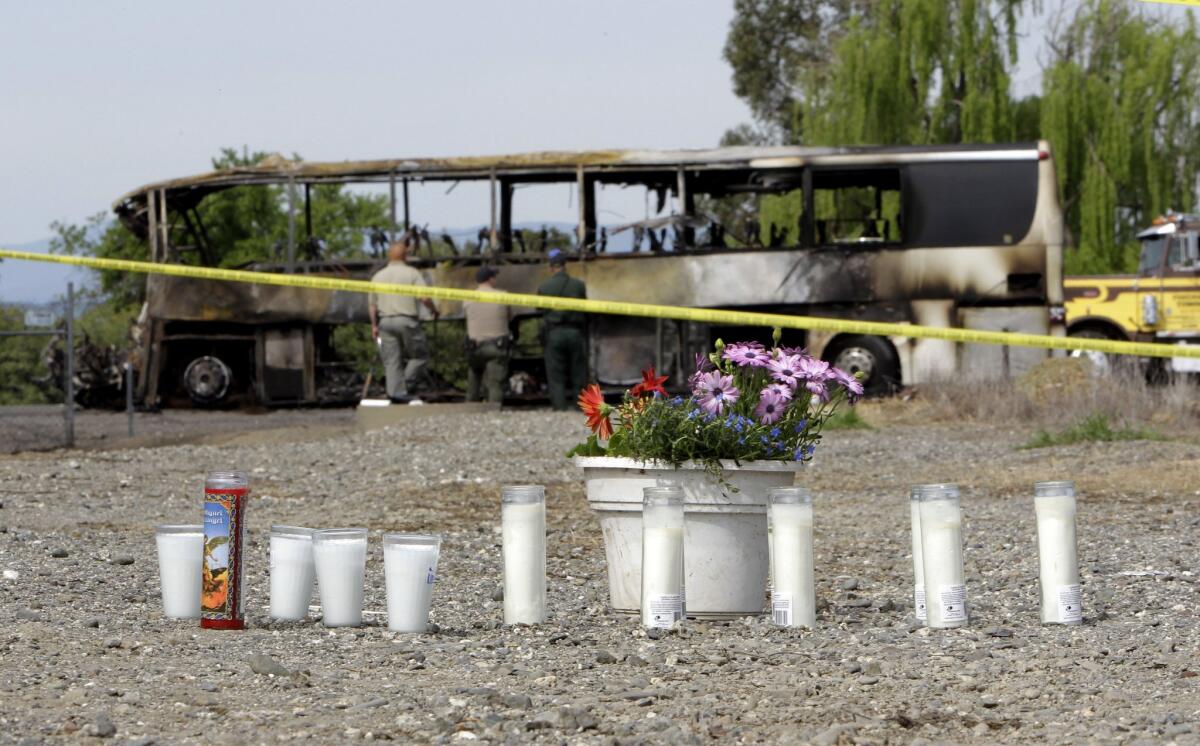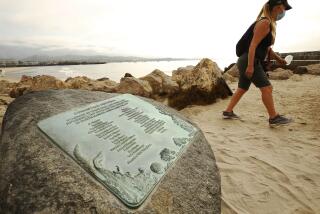Gaps in safety rules contributed to deaths, injuries in Orland bus crash

Candles and flowers are displayed at a makeshift memorial for the victims of a multi-vehicle accident that included a tour bus and a FedEX truck on Interstate 5 in Orland, Calif.
Though unable to determine the cause of a fiery Northern California bus collision that killed five local high school students last year, federal investigators concluded Tuesday that inadequate safety standards hampered the evacuation of the burning motor coach and contributed to the deaths and injuries of passengers.
After a 15-month investigaton, the National Transportation Safety Board could not explain why a FedEx truck driver veered across Interstate 5 near Orland north of Sacramento in April 2014 and slammed head-on into a Silverado Stages bus full of students traveling from Los Angeles to an orientation at Humboldt State University in Arcata.
The board found, however, that outmoded flammability requirements for bus interiors, the lack of pre-trip safety briefings for motor coach passengers and inadequate, poorly-marked emergency exits led to unnecessary deaths and injuries of those aboard the Silverado coach.
Ten people, including the bus and truck drivers, were killed in the crash and an additional 39 were injured, including two people in a small sedan that was also struck by the FedEx truck.
The NTSB announced its findings and recommendations during a board meeting in Washington, D.C.
The panel concluded that the lack of event data recorders on buses and trucks contributed to the NTSB’s inability to reach a firm conclusion on the probable cause of the Orland crash. Such recorders, so-called black boxes, have long been required for railroads, commercial aircraft and ships.
“We cannot undo the terrible toll of the crash,” said Christopher Hart, the NTSB chairman. “We can, however, repeat our urgent message to regulators to take appropriate action to give more passengers a better chance of walking away from any such crash in the future.”
Board members urged the National Highway Traffic Safety Administration and the Federal Motor Carrier Safety Administration to work with bus operators and the trucking industry to implement the NTSB’s recommendations to improve commercial vehicle safety.
They included more flame-resistant materials for bus interiors, event data recorders, a second door for motor coaches to aid in emergency evacuations, pre-trip safety briefings for bus passengers and bus windows that can stay open during evacuations.
“We hope the National Highway Traffic Safety Administration will take action due to this accident,” said Robert Molloy, an NTSB investigator. “Because of the design of the egress systems, passengers were unable to get out.”
Officials for the motor carrier safety administration and the highway safety administration could not be reached for comment Tuesday.
Sean McNally, a spokesman for the American Trucking Assns., said the organization supported the use of many technologies, including event data recorders, that can improve safety. He added that recorders and the information they provide “can be invaluable for agencies responsible for conducting post-crash investigations.”
Dan Ronan, a spokesman for the American Bus Assn., said the group is reviewing the NSTB’s recommendations.
During Tuesday’s NTSB meeting, board members were particularly concerned about outdated federal standards for flame-retardant materials that were formulated in the 1970s for lower capacity buses and designed to combat fires from small-scale sources such as cigarettes.
They noted that today’s motor coaches can carry 80-plus passengers, have more interior fixtures made of flammable plastic and face potential fires from accidents, fuel leaks and mechanical problems. Tougher regulations, they said, would give bus passengers additional time to escape during emergencies.
“The NTSB has been concerned about motor coach and bus interiors for more than 30 years and has issued numerous recommendations to the National Highway Traffic Safety Administration. The standard has not been updated in this time. However, other modes of transportation like rail and aviation have made improvements to the standards,” said Joseph Panagiotou, an NTSB investigator.
Board members said they wanted to close the gap in safety standards between commercial vehicles and other modes of transportation, which have had more stringent regulation for decades.
“This is a real opportunity to level the field a bit,” said board member Earl F. Weener, who noted that passenger aircraft must be evacuated in 90 seconds during emergencies. “One mode should not be a good deal different than another mode.”
NSTB investigators said there was no evidence that the FedEx driver, Tim Evans, 32, was fatigued the day of the crash, became distracted while driving or suffered a serious medical problem before his tractor-trailer veered across southbound Interstate 5 and crossed a 15-foot median into the northbound lanes.
One witness who met Evans for lunch in Weed two hours before the crash reported that he appeared pale and clammy. But NSTB investigators said they could not make any determination because those characteristics could be indicative of a minor or major health problem.
The conclusions are similar to the findings of a California Highway Patrol investigation announced in May.
“This is somebody who never went to the doctor. He exercised and went to the gym three to four times a week. No drugs were found in his system,” said Robert Sumwalt, an NTSB board member. “This whole thing is really a mystery.”
dan.weikel@latimes.com
Follow @LADeadline16 for transportation news
More to Read
Sign up for Essential California
The most important California stories and recommendations in your inbox every morning.
You may occasionally receive promotional content from the Los Angeles Times.











